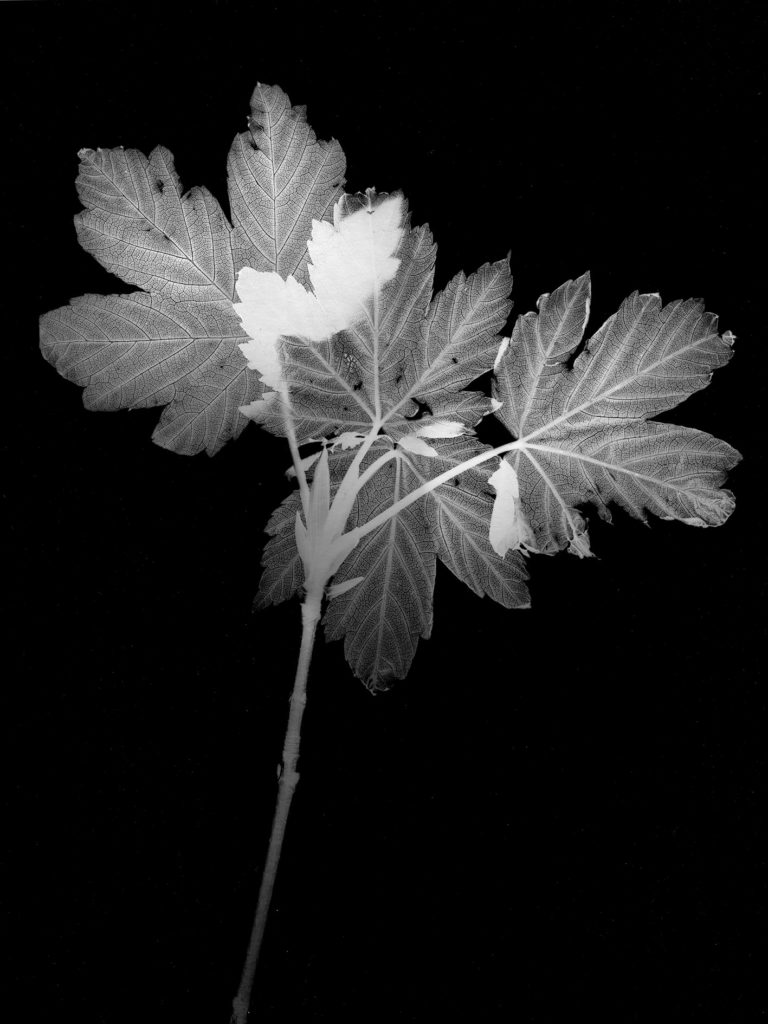Suburban Herbarium, a book of botanical photograms made by William Arnold, was published earlier this month by Uniformbooks, and is the Caught by the River book of the Month for May. Rob St. John reviews.

Sycamore
Acer pseudoplatanus
The photogram is one of the oldest forms of photography. Broadly, the process involves an object being placed on light-sensitive material (most often photographic paper) and exposed to light. What results is an ‘inverted shadow’ on the paper: the object’s form leaving a negative visual space surrounded by a block of exposed colour. In the mid 19th century, British scientists William Henry Fox Talbot and John Herschel independently experimented with using photosensitive paper to document natural forms. Talbot used the process to make visual botanical records of plants and lichens, whilst Herschel developed the cyanotype process, which was quickly adopted by Anna Atkins to make distinctive blue-green prints of marine algae and vegetation.
Almost two hundred years later, photograms – and camera-less photography in general – are still relatively popular forms of image making. If anything, they never really went away in the 20th Century: from Man Ray’s Dada ‘rayographs’, László Moholy-Nagy and György Kepes’ modernist ‘visions’ and ‘landscapes’, and Robert Rauschenberg’s ‘full body’ prints, through to contemporary practitioners such as Susan Derges exposing prints in moonlight through the ripple of river water. In most of this work, the photogram hovers somewhere between the representational and the abstract: the echo of objects from a moment fixed in space and time.
Cornwall-based artist William Arnold is a contemporary photogram practitioner. In 2015 he began documenting the vegetation found on hourly lunchtime walks from his job at Truro College each day, a pattern that resonates with our current lockdown-limited movements. Using silver gelatin photographic paper he began making darkroom photograms of the plants he found on these daily walks. Over time, he amassed one hundred prints of the vegetation of a small patch of land on the outskirts of Truro, which have now been collected in a new book, Suburban Herbarium. In Arnold’s hands (literally), the more-than-documentary photogram techniques of Talbot, Herschel and Atkins find new expression in creatively visualising the – often overlooked – floral biodiversity of a small contemporary city.
The work in Suburban Herbarium is more interesting than elements of its justification. Arnold writes that he chose to focus on ‘edgelands’ in this project, ‘the building sites, road verge, business parks, wasteland and identikit housing, where were it not for the necessity of stable employment nearby one would normally not choose to spend time.’ Really? I wonder when this post-Iain Sinclair schtick of looking for ‘edginess’ in everyday landscapes as a means of justifying having a potter about places where people live and work will exhaust itself in modern British nature writing and art. Such places are often fascinating tangles of human and non-human life, for sure, but there’s the ever-present danger of a voyeuristic overwriting and undermining of their lived realities inherent to this ‘edgeland explorer’ lens. But in Arnold’s work the skilled and specific composition of the prints themselves is more important than this slightly clumsy conceptual framing.
The one hundred images are arranged alphabetically by their Latin name through the book, each a quadrat sample of an individual plant species. Tonally, each image is alike: the exposed space-black of the exposed images bordering an infill of whites and greys tracing the passage of light through the plant material itself. Visually, the X-ray forms of each plant vary greatly: the fishbone-curve of the hard fern, the firework burst of the dutch garlic flower, the constellation lines of hedge bedstraw, the nuclear glow of the sloe. And that’s the beauty of this book: whilst it skilfully isolates the clean, crisp morphology of each individual species, it invites the imagination to wander across different materials and scales. The book itself becomes a landscape, inviting the reader to look allusively with the images, to wander and to wonder through the familiar unfamiliar.
Arnold’s sense of archival curation toes the line between the topologically precise and the gently abstracted. All but one image is arranged vertically on the page (the wild cherry is laid horizontally), and there is no clear sense of scale between them: a scatter of hawthorn leaves takes up similar space to a fan of dock leaves. The plants are plucked from an ankle-level wash of green and exposed to the light: an antidote, he writes, to an everyday ‘plant blindness’, ‘in which we struggle to recognise and appreciate the value of diverse flora.’
He’s probably right, and the images in the book have both aesthetic and ecological value: functioning both as formal artworks and as aids to plant identification, highlighting the distinctive petals, leaves and stems of the specimens. Occupying this space between art and ecology, the images each reveal a sense of materiality, movement and tactility, both in the characteristics of the plants themselves, and in their translation through technology into the image. The flower of the invasive hedge bindweed is imprinted almost as billowing fabric on the page. The brief flash of darkroom light seems to fix as dappled sunlight through clematis leaves; the cross-shaped spores of the fumatory appear airborne. Leaves fold and plant matter is gently flattened in the making of the prints; they may look simple, but their level of clarity and exposure exhibits Arnold’s skill as a photographer.
Not all the plant specimens are elevated by their photogram framing: without its soft colour the printed form of the red campion seems indistinct; without their morphological detail the crushed flowers of the Himalayan honeysuckle become hazy light-flares on the page. But that is really beside the point. Suburban Herbarium is a remarkable feat of visual attentiveness and ability, a book to get lost in and to discover the world anew.
*
Suburban Herbarium is out now and available here in the Caught by the River shop, priced £14.00. You can read Mark Cocker’s introduction to the book here.